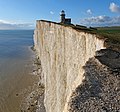Limestone
Limestone is a type of sedimentary rock that is primarily composed of calcium carbonate in the form of the mineral calcite. It also contains other materials such as clay, silt, and sand. Limestone is formed in clear, warm, shallow marine waters and is usually an organic sedimentary rock that forms from the accumulation of shell, coral, algal, and fecal debris.
Formation[edit]
Limestone is formed in two ways. It can be formed with the help of living organisms and by evaporation. Ocean-dwelling organisms such as oysters, clams, mussels and coral use calcium carbonate (CaCO3) from seawater to create their shells and bones. As these organisms die, their shells and bones are broken down by waves and settle on the ocean floor where they are compacted into limestone under pressure.
Types of Limestone[edit]
There are several different types of limestone, including travertine, oolitic limestone, and fossiliferous limestone. Travertine is a form of limestone deposited by mineral springs. Oolitic limestone is made up of small, spherical grains called ooids. Fossiliferous limestone is formed by remains of marine fossils.
Uses of Limestone[edit]
Limestone has numerous uses, including as a building material, as aggregate for the base of roads, as white pigment or filler in products such as toothpaste or paints, and as a chemical feedstock. It is also used in the manufacture of cement, brick, and concrete.
Environmental Impacts[edit]
The production of limestone can have negative impacts on the environment. The burning of limestone to create cement releases CO2 which contributes to climate change. In addition, mining operations can result in habitat destruction and contamination of surface water, groundwater, and soil.
See Also[edit]
Ad. Transform your life with W8MD's Budget GLP-1 injections from $75


W8MD offers a medical weight loss program to lose weight in Philadelphia. Our physician-supervised medical weight loss provides:
- Weight loss injections in NYC (generic and brand names):
- Zepbound / Mounjaro, Wegovy / Ozempic, Saxenda
- Most insurances accepted or discounted self-pay rates. We will obtain insurance prior authorizations if needed.
- Generic GLP1 weight loss injections from $75 for the starting dose.
- Also offer prescription weight loss medications including Phentermine, Qsymia, Diethylpropion, Contrave etc.
NYC weight loss doctor appointmentsNYC weight loss doctor appointments
Start your NYC weight loss journey today at our NYC medical weight loss and Philadelphia medical weight loss clinics.
- Call 718-946-5500 to lose weight in NYC or for medical weight loss in Philadelphia 215-676-2334.
- Tags:NYC medical weight loss, Philadelphia lose weight Zepbound NYC, Budget GLP1 weight loss injections, Wegovy Philadelphia, Wegovy NYC, Philadelphia medical weight loss, Brookly weight loss and Wegovy NYC
|
WikiMD's Wellness Encyclopedia |
| Let Food Be Thy Medicine Medicine Thy Food - Hippocrates |
Medical Disclaimer: WikiMD is not a substitute for professional medical advice. The information on WikiMD is provided as an information resource only, may be incorrect, outdated or misleading, and is not to be used or relied on for any diagnostic or treatment purposes. Please consult your health care provider before making any healthcare decisions or for guidance about a specific medical condition. WikiMD expressly disclaims responsibility, and shall have no liability, for any damages, loss, injury, or liability whatsoever suffered as a result of your reliance on the information contained in this site. By visiting this site you agree to the foregoing terms and conditions, which may from time to time be changed or supplemented by WikiMD. If you do not agree to the foregoing terms and conditions, you should not enter or use this site. See full disclaimer.
Credits:Most images are courtesy of Wikimedia commons, and templates, categories Wikipedia, licensed under CC BY SA or similar.
Translate this page: - East Asian
中文,
日本,
한국어,
South Asian
हिन्दी,
தமிழ்,
తెలుగు,
Urdu,
ಕನ್ನಡ,
Southeast Asian
Indonesian,
Vietnamese,
Thai,
မြန်မာဘာသာ,
বাংলা
European
español,
Deutsch,
français,
Greek,
português do Brasil,
polski,
română,
русский,
Nederlands,
norsk,
svenska,
suomi,
Italian
Middle Eastern & African
عربى,
Turkish,
Persian,
Hebrew,
Afrikaans,
isiZulu,
Kiswahili,
Other
Bulgarian,
Hungarian,
Czech,
Swedish,
മലയാളം,
मराठी,
ਪੰਜਾਬੀ,
ગુજરાતી,
Portuguese,
Ukrainian















